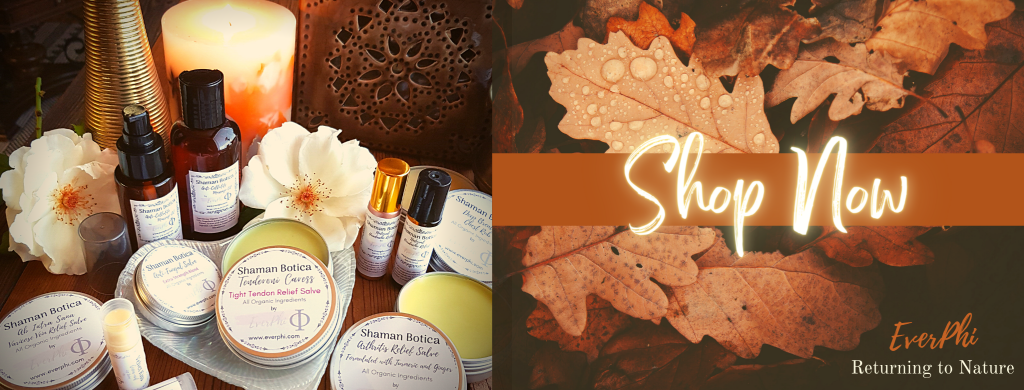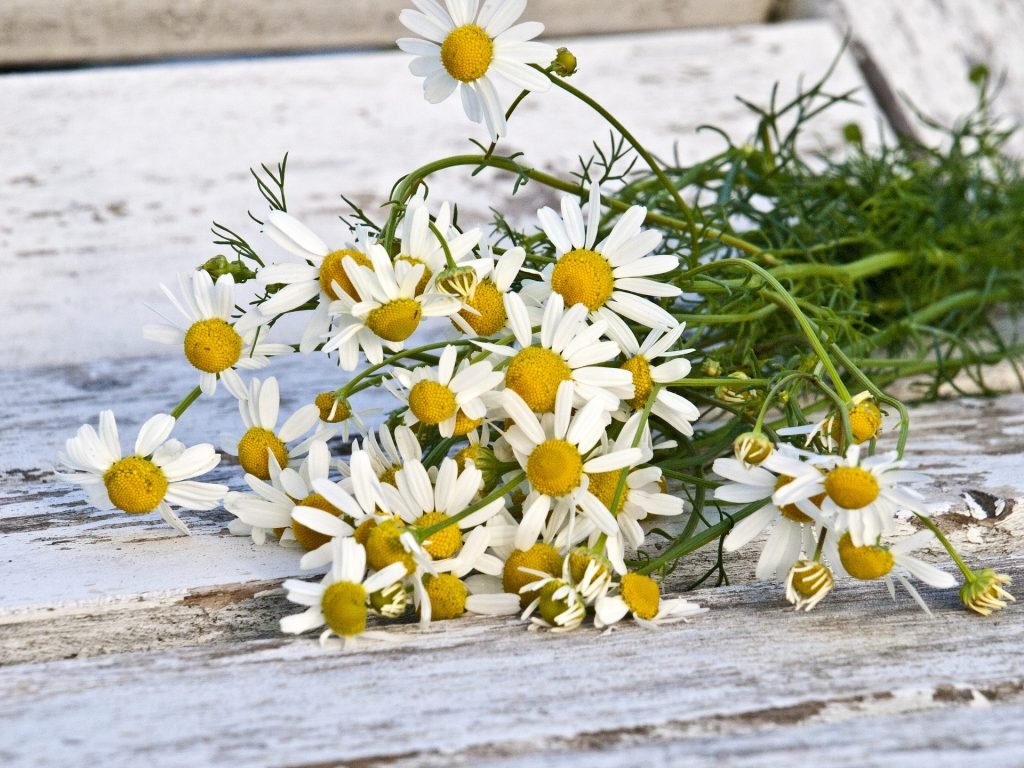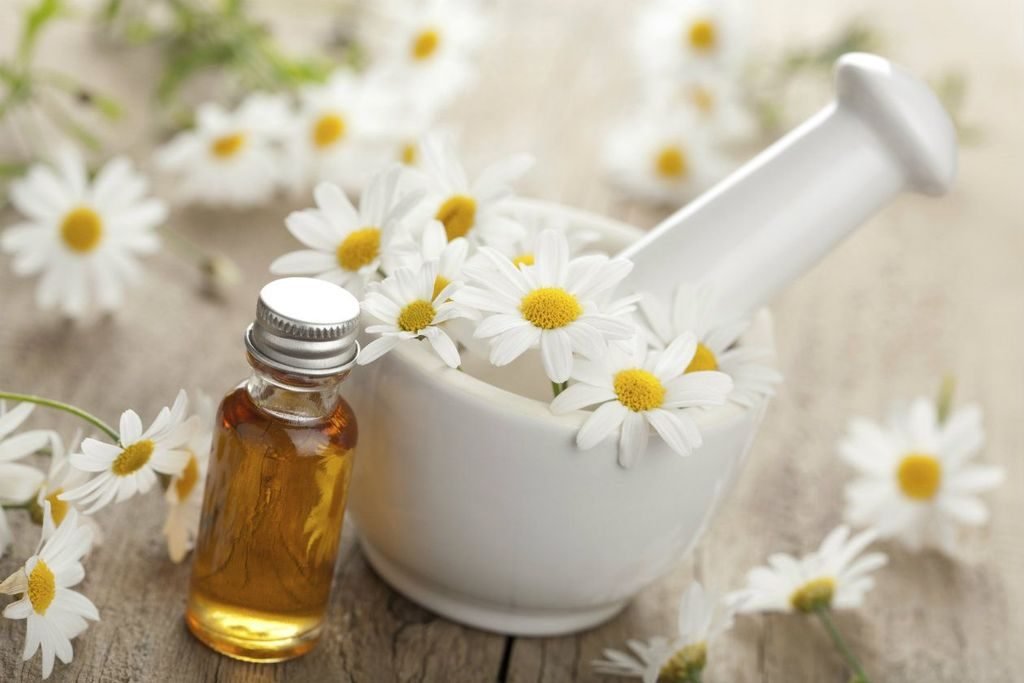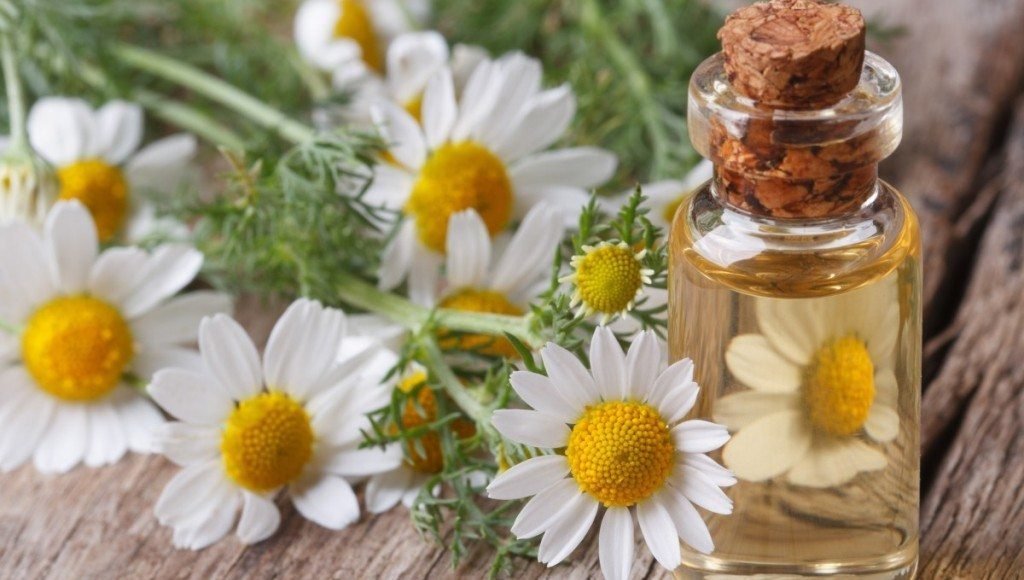
Chamomile essential oil is that obtained by the process of steam distillation or hydro-distillation, in which the flowers are subjected to high pressure, temperature, and steam to separate out the essential oil from them.
The essential oil of chamomile is present in the whole plant. However, the content is higher in the flowers than in other parts of the plant and also, has higher levels of useful compounds. Therefore, the essential oil of the flowers is mostly used for medicinal and aromatic purposes.
At the time of distillation the oil is extremely concentrated, even so, the quality may differ from one variety of chamomile plant to another.
The Chamomile oil blends well with sage essential oil, bergamot, lavender, jasmine, geranium, tea tree, rose, grapefruit and lemon essential oil.
Both types of chamomile, German Chamomile (Matricaria recutita) and Roman Chamomile (Anthemis nobilis) are equally suitable for making oil.
German chamomile is native to Europe and Asia, and is cultivated for commercial use in Hungary, Egypt, France, and Eastern Europe.
On the other hand, Roman chamomile native to Western Europe and North Africa. It is mostly grown commercially in Argentina, England, France, Belgium and the United States.
Both varieties are used for calming and soothing skin, inflammation, fevers, and the nervous and digestive systems, as well as inducing perspiration to flush out toxins, allergens and infections. Besides, both are pain relieving, antibiotic, anti-bacterial, and sedative.
German chamomile essential oil is dark blue in color, Roman chamomile oil, on the other hand, is mostly colorless or pale blue to pale green.
The two main varieties of chamomile are very similar, but it is in their chemical compounds that we begin to see some differences.
Active substances of Roman chamomile are terpenoids: chamazulene, bisabolol; flavonoids: quercetin, apigenin, luteolin; coumarins: scopoletin-7-glucoside and other components like angelic and tiglic acid esters, anthemic acid, fatty acids and choline.
Active principles of German chamomile are terpenoids: α-bisabolol, α-bisabolol oxide A and B, chamazulene, sesquiterpenes; coumarins: umbelliferone; flavonoids: luteolin, apigenin, quercetin; spiroethers: en-yn dicycloether and other components such as tannins, anthemic acid, choline, polysaccharides and phytoestrogens.
Chamomile history begins in ancient Egypt, where it is mentioned for the first time as a cure for fever, often called the “ague”. While also, the crushed flowers rubbed on the skin as a cosmetic treatment. The Egyptians used its essence as the main ingredient in embalming oil for preserving deceased pharaohs.
The word “chamomile” comes from ancient Greece, “Chamomaela”, and means “ground apple“. Pliny the Elder mentions the similarity of chamomile flower smell to the apple blossom and this may be why the ancients used the term.
In Spain chamomile flower called “manzanilla” (“little apple”) was known for its use to flavor a light sherry called by the same name. The Norsemen put it in a kind of shampoo. It was thought to add luster to the braided locks.
In Medieval times the petals were strewn about at gatherings to create pleasant odors.
Chamomile also added flavor to beer before hops were put to that use. These plants had a milder taste.
Although the seeds were sterile, the harvest was done by cloning. Chamomile was widely used in tisanes and as a medicinal herb.
What is today known as Roman Chamomile was not actually cultivated by the Romans. However, an English botanist discovered growing wild in the Coliseum.
He brought it back to England where it is one of the primary forms of chamomile now cultivated. Chamomile is not native to the Americas, but was brought over and planted by colonists. Eventually, the seeds made it into the wild. It can now be found in yard and field, as well as in the garden.
Chamomile has anti-inflammatory, deodorant, antibiotic, antimicrobial, carminative, sedative, antiseptic, antispasmodic, anti-allergic, anti-pruritic, healing, decongestive, antidepressant, anticonvulsant, anxiolytic, antiemetic, antitoxic, antirheumatic, coagulant, cicatrizant, digestive, diuretic, emollient, stomach, stimulating, splenic, hepatic, febrifuge, litolitic, relaxing, sudorific, vermifuge, vulnerary, analgesic, tonic, bactericidal, calming, anticatarrhal and spasmolytic properties.
The properties of chamomile essential oil are efficient in relieving or treating:
Ideally, you should dilute chamomile essential oil with a softer carrier oil for topic use. You can try with apricot kernel oil, almond oil or coconut oil, among others.

The essential oil of chamomile is extensively used in aromatherapy, massage, and baths. The oils are absorbed into the body on inhalation and through the skin. Thus, the compounds penetrate the skin and enter the bloodstream and act as medicines.
Aromatherapy is a technique of healing where the patient is made to inhale the vapors of the essential oil.
A few drops of chamomile oil are applied on a piece of cloth or handkerchief or tissue and slowly inhaled.
Sometimes a few drops of oil are added to hot water and the steam is inhaled. Chamomile oil vapor is used extensively in aromatherapy to calm a person and reduce pain and anxiety.
A massage with oil enables the medicinal compounds to penetrate the skin and enter the bloodstream.
For the purposes of massages, the chamomile oil used is diluted with other oils such as olive, almond, apricot kernel or lavender oil.
The oil is gently rubbed or massaged on to the inflicted part.
In many disease conditions, a hot bath or a cold bath is given to a patient. In hot baths, warm to hot water is used and in cold baths, cold water or ice is used. A few drops of chamomile essential oil are added for healing purposes. Sometimes whole chamomile flowers are put in a small bag and kept in the bath.
A compress is made by steeping a cloth or a towel in a bowl of hot (hot compress) or cold (cold compress) water.
A few drops of chamomile oil are added in the water before steeping the cloth or towel. This compress is then applied to the affected part.
For an internal consumption there are two ways of consumption:

In general, chamomile essential oil is safe, since it is neither toxic or irritating.
Additionally, the U. S. Food and Drug Administration (FDA) have classified the oil and extract of German and Roman chamomiles as substances which named Generally Regarded As Safe. However, it may have side effects.

No studies have reported the safety of using chamomile for women who are pregnant or breastfeeding, although chamomile is widely consumed during pregnancy as a beverage to treat morning sickness. However, avoid the use of Chamomile essential oil in large concentrations, because this plant can cause uterine contractions, and also, can affect the baby through milk.
Generally, good quality oils, that is, 100% pure and not mixed with other substances, can be found in specialized natural herb stores.